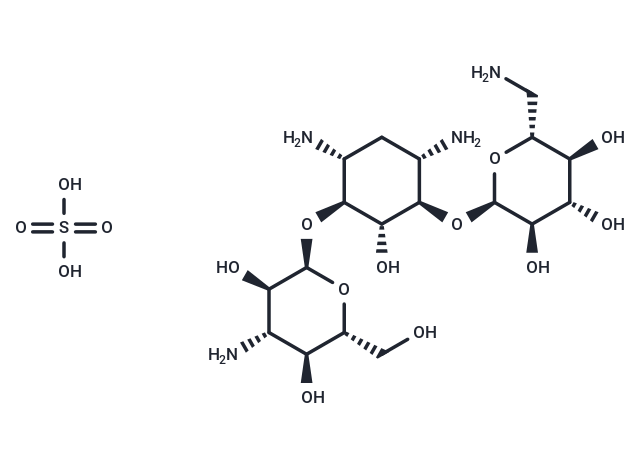Shopping Cart
Remove All Your shopping cart is currently empty
Your shopping cart is currently empty
Kanamycin sulfate (Kanamycin monosulfate) is an aminoglycoside antibiotic that interferes with protein synthesis by binding to the 70S ribosomal subunit of bacteria. Kanamycin sulfate exhibits antimicrobial activity against both Gram-positive and Gram-negative bacteria, as well as mycoplasmas.

| Pack Size | Price | USA Warehouse | Global Warehouse | Quantity |
|---|---|---|---|---|
| 200 mg | $41 | In Stock | In Stock | |
| 1 mL x 10 mM (in H2O) | $50 | In Stock | In Stock |
| Description | Kanamycin sulfate (Kanamycin monosulfate) is an aminoglycoside antibiotic that interferes with protein synthesis by binding to the 70S ribosomal subunit of bacteria. Kanamycin sulfate exhibits antimicrobial activity against both Gram-positive and Gram-negative bacteria, as well as mycoplasmas. |
| Targets&IC50 | Kirchbergand:1 µg/mL (MIC), various strains of mycobacteria:1-5 μg/mL (MIC) |
| In vitro | METHODS: Human cell lines HEK293, OVCAR8 and CA46 were treated with Kanamycin sulfate (0-1 mM) and cell viability was measured using the CCK-8 assay. RESULTS: Kanamycin showed no cytotoxic effects in any of the cell lines. [1] METHODS: Mycobacteria H37Rv, H2, H37RvR-PAS, Ravenel, Kirchbergand and BCG were treated with Kanamycin sulfate (0.1-100 µg/mL) for 2 weeks and tested for antibacterial activity. RESULTS: Kanamycin showed good antimicrobial activity against various Mycobacterium species with MICs of 1 µg/mL and 5 µg/mL for Kirchbergand strains, respectively. [2] |
| In vivo | METHODS: To detect ototoxicity, Kanamycin sulfate (800 mg/kg) was administered subcutaneously to C57BL/6J mice twice daily for fifteen days. RESULTS: Different ototoxic regimens were evaluated by ABR and DPOAE measurements before and after treatment. Sensory cell loss was quantified by counting hair cells in the cochlea. The study demonstrated that the Kanamycin ototoxicity regimen was safe, well tolerated, and detected early significant changes in hearing thresholds by DPOAE in a small group of mice. [3] |
| Synonyms | Ophtalmokalixan, Kanamycin monosulfate, Kanamycin A monosulfate |
| Molecular Weight | 582.58 |
| Formula | C18H38N4O15S |
| Cas No. | 25389-94-0 |
| Smiles | OS(O)(=O)=O.NC[C@H]1O[C@H](O[C@@H]2[C@@H](N)C[C@@H](N)[C@H](O[C@H]3O[C@H](CO)[C@@H](O)[C@H](N)[C@H]3O)[C@H]2O)[C@H](O)[C@@H](O)[C@@H]1O |
| Relative Density. | 1.3619 g/cm3 (Estimated) |
| Storage | Powder: -20°C for 3 years | In solvent: -80°C for 1 year | Shipping with blue ice/Shipping at ambient temperature. | |||||||||||||||||||||||||||||||||||
| Solubility Information | H2O: 100 mg/mL (171.65 mM), Sonication is recommended. DMSO: Insoluble | |||||||||||||||||||||||||||||||||||
Solution Preparation Table | ||||||||||||||||||||||||||||||||||||
H2O
| ||||||||||||||||||||||||||||||||||||
| Size | Quantity | Unit Price | Amount | Operation |
|---|

Copyright © 2015-2025 TargetMol Chemicals Inc. All Rights Reserved.